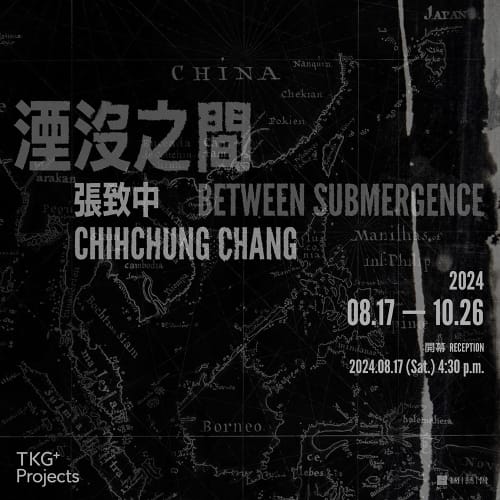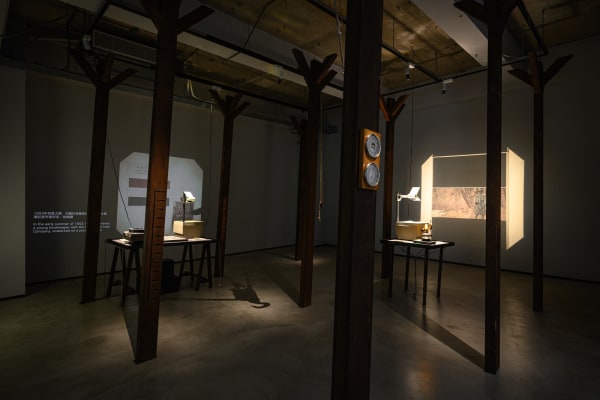Between Submergence: ChihChung Chang solo exhibition
-
Overview
Dates
17 AUGUST - 26 OCTOBER 2024
Reception
17 AUGUST (SAT.) 4:30 P.M.
Venue
TKG+ Projects 2F, No. 15, Ln. 548, Ruiguang Rd., Neihu Dist., Taipei, Taiwan
Imagine a drop of water flowing toward the valleys and the sea, drop by drop, a thousand years have passed. Where will it go? When will it converge? Into which estuary will it flow, forming which ocean current? If every memory of the sea belongs to a collective memory — can we say that between the sinking of past memories and the rising of today’s waters, the reflective gaze mirrors history, the tides of the past ebbing along a blurred, illusory coastline. A similar feeling could be evoked as the viewer steps into Between Submergence, the solo exhibition of Chihchung Chang at TKG+ Projects, comprising sculptures, archives, and an immersive video installation. He imagines a dilapidated shipwreck as a metaphor for historical triggers, and our bodies as chapters of world history. Starting from an island in the Pacific Ocean, tracing the west to the east, and the south to the north, the ship morphs into a wanderer through time.
-
Hendrick Hamel, a bookkeeper for the Dutch East India Company, set sail on the ship De Sperwer from Tayouan, Formosa (today’s Tainan, Taiwan) to Nagasaki, Japan in 1653, before encountering a typhoon in the East China Sea, causing the ship to run aground and sink. Hamel and the crew accidentally landed on Jeju Island, Korea, which had not yet been charted on Western maps, and were captured and sent to Seoul. After 13 years of detention, they finally escaped and sailed back to the Netherlands. By the time they embarked on the journey home, Formosa had disappeared from their return route due to a change in colonial rule. Hamel’s Journal and a Description of the Kingdom of Korea 1653–1666, his travel record published by the East India Company, made him the first European to reveal the then-isolated Kingdom of Korea to the West, earning him the title of the Dutch Marco Polo.
Inviting the viewer to embark on a voyage on a shipwreck, this exhibition reimagines a new route 371 years later since Hamel first set sail. It signifies the unwritten pages in Hamel’s journal when he passed through Taiwan, beginning from Chang’s personal and external experiences in his southern port hometown of Kaohsiung, expanding to the artist’s residency in Europe, his time spent away from home, traversing unfamiliar lands, and coming close to water.
Through the twilight of memory and history, a centuries-old journal about a maritime disaster transforms from something of autobiographical nature into part of public historical archives. Divided into three sections, the exhibition space embodies a ship in different stages: sinking in the water, immersed in the water, and a connecting passageway, where the viewer follows the artist as he revisits and deconstructs Hamel’s journal.
-
-
Tracing the watermarks, the viewer is overwhelmed by a sense of descent upon entering the first section of the space. Half-tilted ship spars in Marine Weather Forecasting (2024) confront the viewer, aligned with the sea level projected on the wall in First Submergence (2024), where manuscripts, mythological and folklore texts, archives, photographs, and maps are on display. Fluctuating sounds of waves, as well as a voiceover that recounts Hamel’s life, and the colonial past of Taiwan and its surrounding regions, together chronicle real historical events, juxtaposed with ostensibly authentic archives.
The viewer steps into the connecting passageway, where Hamel’s journal is on display, filled with traces of overwriting and obliteration. In this space of detachment, the artist allows the viewer to relive memories, charting their own imagined route. From this moment on, the authenticity of memory becomes irrelevant. What enwraps the viewer is the eternal present, conjured between archive and fiction.
Not until seeing fog swirls at the far end of the space does the viewer realize that this exhibition, animated by a video installation and an array of images, holds a deeper secret about what lies under the sea. Between Submergence (2024) greets the viewer with two pieces of suspended ship sail, upon which a video of undulating water is projected. Submerged in the undersea ambience, the viewer witnesses the changing state of the sail rendered in hydrochromic ink, rippling in nuance.
Between the humidity and mist, reality becomes fiction, and history, premonition. The juxtaposition of the three sections evokes a transitional state, as hinted by the title “Between Submergence”: afloat and immersed, obscure and lucid, invented and real. What concerns the artist is not merely historical veracity, but the distance between memory and reality. Water is intended as the ultimate catalyst in this exhibition, as it dissolves or produces traces, obliterating or revealing them at will.
If archives are a carrier of human memory, is it possible for a shipwreck installation to serve as a form of archives? Chihchung Chang: Between Submergence at TKG+ Projects pivots on hydrology as historical text to explore the possibilities of archives. As colonial historical archives are ambiguous and fragmentary, this exhibition aims to disrupt the perception of archives as a way to restore, corroborate, or attest to history. This attempt, while deconstructing archives, departs from the linear method of textural research. A marine mishap re-enacted through a shipwreck installation; the colonial history of the Pacific retold through a look at the ocean; everything anchored by water as the central theme. Across the eternal surging tides, whether for Hamel from 371 years ago, or ChihChung Chang, who has created this shipwrecked seascape, or the viewer in the present world, the ocean’s water serves as a perpetual vessel for time and space.
-

© ChihChung Chang
-
Works
 張致中 ChihChung Chang, 第二次湮沒 Second Submergence, 2024
張致中 ChihChung Chang, 第二次湮沒 Second Submergence, 2024 張致中 ChihChung Chang, 太陽雨 – 台灣 Sunshower - Taiwanese, 2024
張致中 ChihChung Chang, 太陽雨 – 台灣 Sunshower - Taiwanese, 2024 張致中 ChihChung Chang, 太陽雨 – 日本 Sunshower - Japanese, 2024
張致中 ChihChung Chang, 太陽雨 – 日本 Sunshower - Japanese, 2024 張致中 ChihChung Chang, 太陽雨 – 印尼 Sunshower - Indonesian, 2024
張致中 ChihChung Chang, 太陽雨 – 印尼 Sunshower - Indonesian, 2024 張致中 ChihChung Chang, 太陽雨 – 法蘭德斯 Sunshower - Flemish, 2024
張致中 ChihChung Chang, 太陽雨 – 法蘭德斯 Sunshower - Flemish, 2024 張致中 ChihChung Chang, 太陽雨 – 韓國 Sunshower - Korean, 2024
張致中 ChihChung Chang, 太陽雨 – 韓國 Sunshower - Korean, 2024












